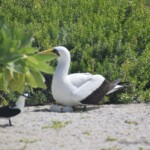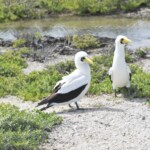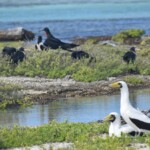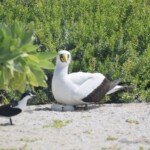Finding Lulu
In our recent vaka voyage to the northern group we were fortunate to see the native seabird Lulu (Masked Booby/ Sula dactylatra) nesting on a couple of the islets along the Seven Sisters in Suwarrow. The Lulu is not common in the Cook Islands and is listed in the Cook Islands Biodiversity & Natural Heritage database as being Nationally Endangered (Seriously). However they are not considered to be threatened or at risk globally.
Lulu are plunge diving seabirds that belong to the booby and gannet family, Sulidae. It is the largest of all boobies and is one of three different species found in the Cook Islands, the others being the Red footed booby (Toroa) and the Brown booby (Kena).
The dark skin surrounding the eyes and bill explains how it came to be called ‘Masked’ and the name Booby comes from the term ‘bobo’, which is Spanish slang for ‘stupid’. These birds are anything but stupid, just fearless of humans and too easily captured by 18th century Spanish sailors, hence earning them the nickname.
Though not very common, Lulu are found in the makatea islands of the southern group as well as in Tongareva, Suwarrow, Pukapuka and Palmerston, where they are locally named Kena. The Lulu has also been seen as far south as Rarotonga, foraging outside Rarotonga’s reef.
Spectacular plunge divers, they catch fish, squid and octopus and will even chase their prey underwater using their legs to swim. This style of feeding means they have adapted some interesting physical characteristics such as a torpedo shaped bodies and eyes well forward on their face giving them excellent binocular vision. They also have air sacs under their skin around their face and chest, which cushion the impact with the water, a bit like bubble wrap.
When we were last in Suwarrow in 2018 we noticed some interesting courtship behaviour between a couple of lulu birds. One of the pair had found a nice smooth flat rock and would push this rock towards its prospective partner, almost as a sign of affection or a prized jewel.
Other elaborate courting displays include sky pointing, where the male throws his head back pointing his beak towards the sky, and whistles. They also ”parade” which is the funny swagger both sexes do, waggling from side to side, with their tails pointing straight up in the air.
When these birds are seen close to land, you know that a breeding location is likely nearby. Nests are typically spaced far apart from other nesting boobies. Lulu are a low fuss sea bird nesting straight onto the raised sand. No twigs or leaves required.
While in Suwarrow a few weeks ago, we observed both male and female birds on the nest, sharing incubation. Both sexes also share brooding and chick rearing, almost as if the parents were keeping each other company.
Usually two eggs are laid and are incubated under the webs of the feet. Interestingly, the birds feet get hot in a process called vascularisation where the blood vessels expand and heat up. A handy technique for keeping the eggs nice and cozy.
Another fascinating fact about boobies, is how it is one of several species of birds that performs ‘siblicide’. This is when one hatchling will force the other out of the nest, only days after birth. The second chick born generally does not survive, killed by its elder sibling. Survival of the fittest!
Boobies are threatened by habitat loss and depleted food sources influenced from a range of stressors from climate change to ocean pollution and overfishing.
Our seabirds deserve all the recognition they can get. They play an important role in providing a bridge of new nutrients from the ocean to land. Plus they are just stunning animals to observe both at sea and land.
As published in the Cook Islands News August 28 2021
